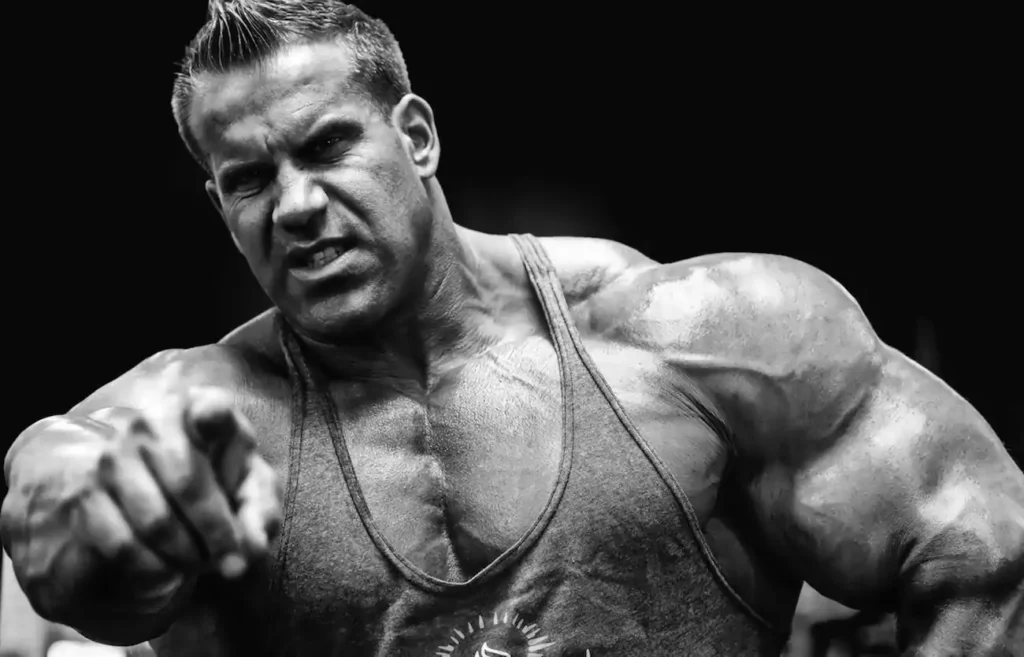Jay Cutler is one of the iconic figures in modern bodybuilding. He won the Mr. Olympia title four times, dethroning Ronnie Coleman in 2007 and Dexter Jackson in 2009.
He is the only modern bodybuilder to regain the title after losing it, and only the third in bodybuilding history to do so, following Arnold Schwarzenegger and Franco Columbu. His list of accomplishments includes many other titles, including three consecutive wins at the Arnold Classic.
In this article, we’ve compiled interesting facts about bodybuilder Jay Cutler: his biography, interviews, achievements, training features, and an example of a weekly workout routine during his preparation for the Mr. Olympia competition.
In the interview below with the outstanding bodybuilder Jay Cutler, you'll find a beautiful story about how to train properly in bodybuilding: about nutrition, workouts, and the importance of patience and consistency... with no mention of pharmacology, which, as is well-known, is the driving force behind modern bodybuilding, which has long ceased to be natural. This is confirmed by the words of one of the last natural bodybuilders, Michael Ashley, as well as an anonymous confession from a pro bodybuilder.Bodybuilder Jay Cutler
Website: www.jaycutler.com
Instagram: @jaycutler
Date of Birth: August 3, 1973
Place of Birth: Las Vegas, USA
Anthropometric Data:
Height: 178 cm
Off-season weight: 132 kg
Competition weight: 118 kg
Biceps: 56 cm
Chest: 150 cm
Thighs: 76 cm
Waist: 86 cm
Calves: 51 cm
We recommend: What Is Pumping?
Titles and Achievements in Bodybuilding
2010 Mr. Olympia – 1st place
2009 Mr. Olympia – 1st place
2008 Mr. Olympia – 2nd place
2007 Mr. Olympia – 1st place
2006 Mr. Olympia – 1st place
2005 Mr. Olympia – 2nd place
2004 Mr. Olympia – 2nd place
2004 IFBB Arnold Classic – 1st place
2003 GNC Show of Strength – 2nd place
2003 IFBB Arnold Classic – 1st place
2003 Dutch Grand Prix – 1st place
2003 British Grand Prix – 1st place
2003 Russian Grand Prix – 2nd place
2003 Mr. Olympia – 2nd place
2003 San Francisco Pro Invitational – 1st place
2002 IFBB Arnold Classic – 1st place
2001 Mr. Olympia – 2nd place
2000 Mr. Olympia – 8th place
2000 Joe Weider’s World Pro Cup – 2nd place
2000 Grand Prix England – 2nd place
2000 Night of Champions IFBB – 1st place
1999 Ironman Pro Invitational IFBB – 3rd place
1999 Arnold Classic IFBB – 4th place
1998 Night of Champions IFBB – 12th place
1996 Nationals – NPC, HeavyWeight – 1st place
1993 Teen Nationals – NPC, HeavyWeight – 1st place
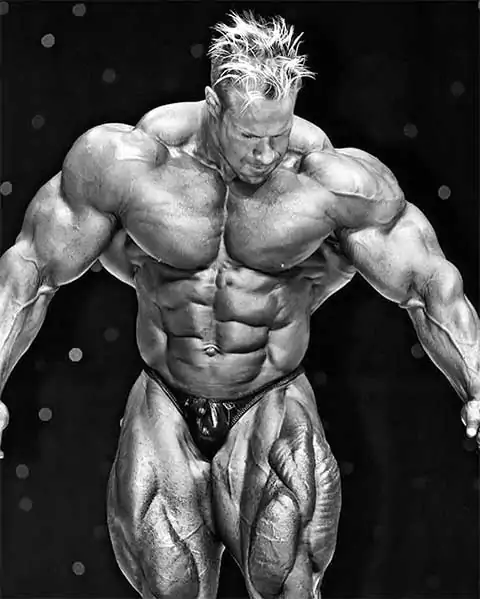
Facts About Jay Cutler
Favorite food: Steak.
Favorite pastime: Various sports.
Biggest influence: Family.
Brand partnerships / sponsors: ISS Research and Flex Equipment (1 year).
Biggest fears: Fear of failure, financial stability.
Interesting fact that few people know about Jay Cutler: Jay started working in the family construction business, Cutler Brothers Concrete, at the age of 11.
Started bodybuilding: Upon entering college.
Body parts he loves to train: Legs and delts.
Favorite exercise: Walking barbell lunges.
Favorite cheat meal: Low-fat frozen yogurt.
Favorite movies: Die Hard with Bruce Willis.
Favorite actors: Robert De Niro and Bruce Willis.
Favorite sports: Basketball and football.
Favorite musical artists: The Cure, Tupac Shakur, and Snoop Dogg.
Pets: Cockapoo (a mix of Cocker Spaniel and Poodle) and an Airedale Terrier.
Hobbies: Reading, bowling, motocross, and animals, especially dogs.
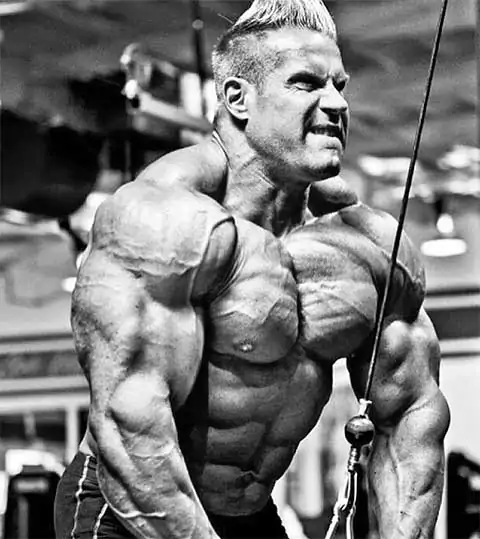
Biography of Jay Cutler
Jay Cutler started working in his brother’s construction business, which specialized in concrete structures, at the age of 11.
At 18, he began training in bodybuilding.
In 1993, he graduated from college with a degree in criminal justice, intending to work as a corrections officer in a maximum-security prison.
He was particularly inspired to pursue bodybuilding seriously after meeting Marcos Rodriguez. Jay wanted to become one of the greatest bodybuilders of all time.
The first competition he participated in was the Gold’s Gym Bodybuilding Championship in Worcester, where he placed 2nd.
As Jay Cutler became well-known in the bodybuilding world, he frequently appeared in bodybuilding films, including Battle for the Mr. Olympia 2001, a documentary about the preparation of various athletes for the 2001 Mr. Olympia competition.
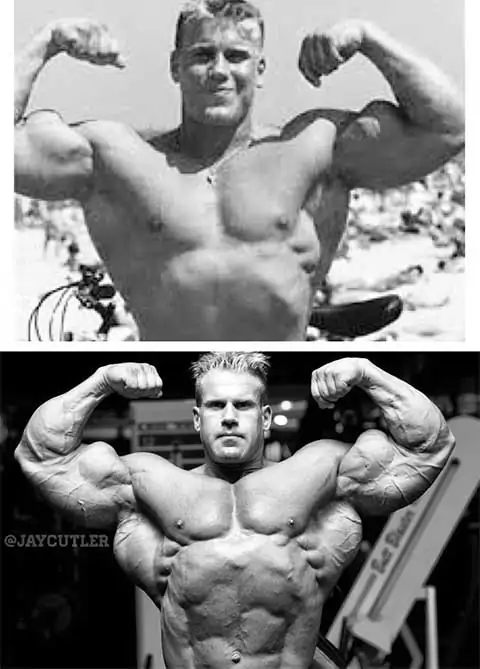
Jay Cutler won the Arnold Classic consecutively in 2002, 2003, and 2004 and placed 2nd at Mr. Olympia four times, finishing behind Ronnie Coleman, until he finally took 1st place in 2006.
At Mr. Olympia, Jay Cutler initially failed the doping test as a banned diuretic was found in his urine, but he took legal action and reclaimed his 2nd place title.
In 2007, Cutler once again won Mr. Olympia, making it his second consecutive victory. In 2009, he became the third bodybuilder in history (after Arnold Schwarzenegger and Franco Columbu) to regain the Mr. Olympia title after losing it in 2008 when Dexter Jackson took 1st place.
In 2010, Jay Cutler won Mr. Olympia for the fourth time. However, in 2012, due to a biceps injury, Cutler could not compete in Mr. Olympia, much to the delight of his competitors. In 2013, he only placed 6th at the competition.
After this, Jay Cutler began focusing more on his business ventures: he launched his own sports nutrition brand, Cutler Nutrition, developed an online coaching program, and worked on expanding his presence on social media.
Today, Cutler lives in Las Vegas. In 1998, he married a woman named Kerry, but the marriage was short-lived, and they soon divorced.
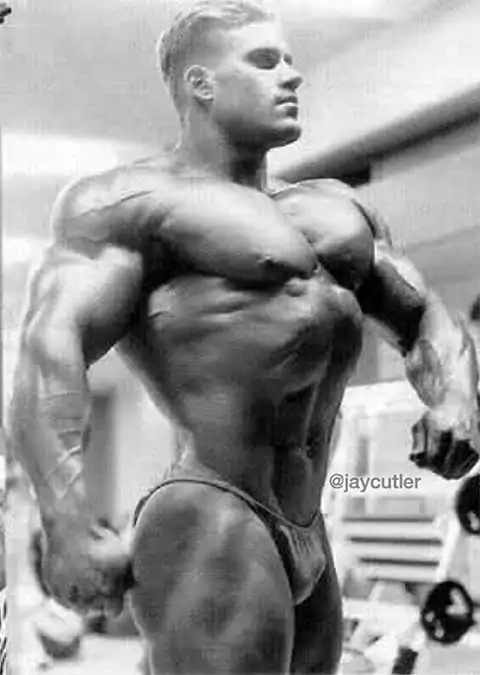
Interview with Jay Cutler: The Evolution of Training
- How did you start bodybuilding?
The first time I went to the gym was on my 18th birthday, August 3, 1991.
My sister’s boyfriend was collecting bodybuilding magazines at the time, and I started doing the same: I was finding every magazine with Chris Dickerson on the cover. These were old issues scattered around the house.
I already had a developed physique from working in the family construction business for many years, but I decided I wanted to go further and look like the guys on the magazine covers.
- Chris Dickerson? It doesn’t seem like the sixth Mr. Olympia winner had the kind of physique you eventually showed on stage…
I remember his calves and muscularity well. The year of the magazine I had was the year he became Mr. Olympia.
At the time, he was the best, and I knew that to win shows, I had to look at least as good as him. What I ultimately achieved doesn’t necessarily have to resemble the example I started with.
Back then, at the very beginning, I was muscular but not lean enough. Gradually, I got bigger and bigger, and eventually became a bodybuilder focused more on mass rather than aesthetics.
At 16, I bought a bodybuilding book by Bob Paris, Beyond Built. It was my first bodybuilding book, and it taught me exercise techniques.
In 2004, I wrote my own book, CEO Muscle, which is very similar to Paris’ book. That book is still in my collection.
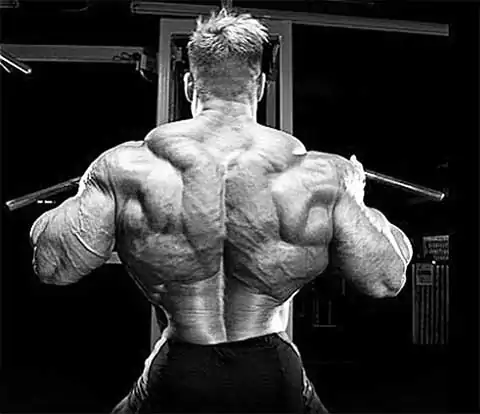
- What mistakes do you think you made at the beginning of your bodybuilding journey?
I definitely overtrained. I trained way too much.
Chris Dickerson taught me a lot about nutrition in bodybuilding and created a daily meal plan for me, each day consisting of six meals. I hung it on the fridge and followed it exactly, adhering to the portion sizes and types of food.
Once I started following that nutrition plan, I began progressing very quickly. So, even though I was overtraining, I was paying close attention to my nutrition and getting enough nutrients.
“…I started progressing quickly as soon as I began meticulously following the nutrition plan created for me.”
Jay Cutler on nutrition
- Looking at you, it’s clear that your legs are a body part that you can easily train. Which muscles are the hardest for you to train?
I think it’s my chest, because I’m very broad and my shoulders are very big. I had to learn how to build my chest muscles; I have a very large ribcage. I had to learn how to work the chest muscles instead of just pressing weights, as I was very, very strong.
I needed to figure out how to get my chest muscles to contract: now, when I train, I perform the exercises so that my chest touches my chin with every rep, and that’s when I feel the chest muscles contract.
It was also very difficult for me to make my arms grow. My calves are very small compared to my thigh muscles.
Underdeveloped back muscles prevented me from beating Ronnie Coleman in the early years of my Mr. Olympia participation. I had to work hard on them, doing lots of pull-ups and bent-over T-bar rows.
In reality, I’m constantly trying to improve. I’m not genetically gifted to be Mr. Olympia, and I think I’ve done a pretty good job of earning that title.
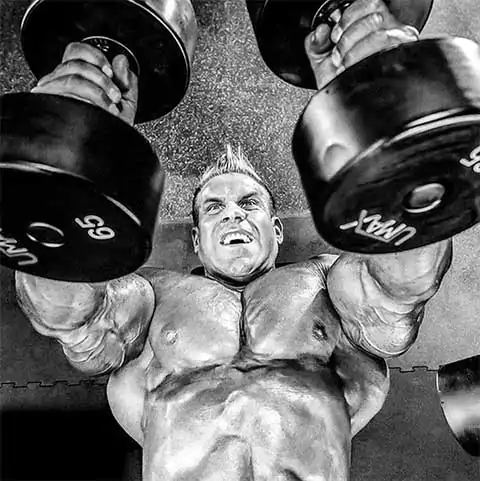
- Do the exercises you perform change over time?
I do everything possible: I constantly bring variety into my workouts.
I regularly squat, and then I start squatting with my heels elevated.
I constantly switch between dumbbells, barbells, and machines. When I became a professional bodybuilder, I started using Hammer Strength machines more often because I gained access to them.
But overall, I always prefer heavy free weights.
When I began preparing for Mr. Olympia, in order to beat Ronnie Coleman, I started using the T-bar row and front squats with the barbell, and doing barbell lunges—things I never did at the start of my career.
We recommend: Training Journal: Manage the Load!
“…I always prefer heavy free weights.”
Jay Cutler on training
Recommended: Growth Hormone in Bodybuilding: Side Effects and Consequences of Use | Expert Reviews
- Are there any exercises that you dislike doing and try to avoid?
In my youth, squats were always my favorite exercise. As I got older, they became a bit harder to perform. When I was able to squat 317 kg, I felt there was no need for such heavy weights.
Later on, after I won Mr. Olympia, I never went above 183 kg in squats and stuck to 12-15 reps.
“…after I won Mr. Olympia, I never exceeded 183 kg in squats and did 12-15 reps.”
Jay Cutler
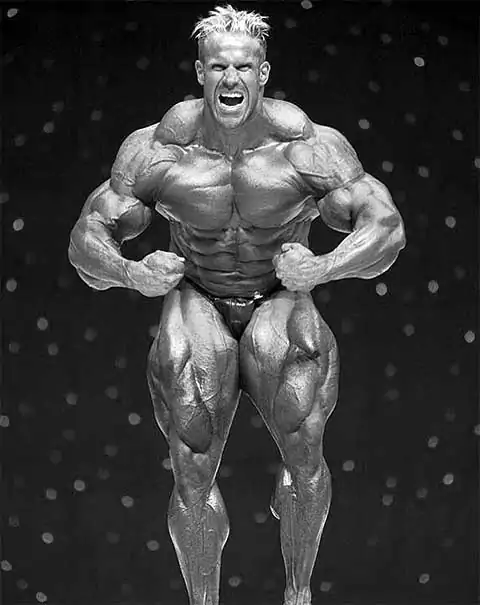
- Are you one of those guys who always tries to push for “just one more rep”?
No.
I always tell everyone that I bench-pressed 250 kg twice only once in my entire life. I never tried again. Most likely because I was a professional bodybuilder and simply didn’t want to risk getting injured by lifting weights that were unnecessary.
Many guys make the mistake of thinking that intensity equals the weight you’re using. But no one really knows what intensity is. For me, training intensely means resting less between sets.
The foundation of bodybuilding is the ability to focus and visualize.
“For me, training intensely means resting less between sets.”
Jay Cutler on training
- When someone meets you on the street and asks, “How much can you lift?” what do you say?
“Very much” or I just laugh. But inside, I’m thinking, “Here we go again…”
Of course, I’m never rude to anyone. Very often, I joke and sarcastically say that I only train on weekends.
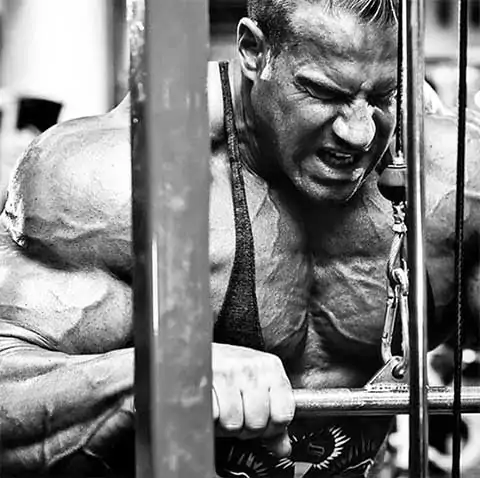
- You and Phil Heath train differently than Ronnie Coleman, and that’s probably why you avoid the injuries guys like him often get?
Actually, I did get injured at the end of my career, but I do avoid the madness in training.
Phil Heath didn’t take anything from me; he’s a genetic monster, and his goal is heavy weights and muscle growth. I also trained with heavy weights at the beginning to build muscle mass, but today I don’t, and that’s why I don’t have the same size.
But Phil and I train in a similar way only because we don’t want to get injured. It’s very important to train while listening to your body.
“…today I don’t train with heavy weights because I don’t want to get injured… it’s important to train by listening to your body.”
Jay Cutler on training
- How necessary is it for a pro bodybuilder to have a personal coach/nutritionist/expert today?
I’ve always had someone. An extra pair of eyes never hurts.
At certain times, I needed help with nutrition. I was always in good shape, but to figure out the exact amount of calories I needed, it took a long and hard process to fine-tune my diet.
If you ask my personal trainers who their most difficult client is, they would definitely say it’s me.
In nutrition, I’ve always tried to find the balance between having lean muscle mass and not losing it. When I have 400 grams of carbs in my diet, I start gaining fat. I have a crazy metabolism.
Of course, like everyone, I face the challenge of holding water when I eat a lot of carbs. My regular weight is 132 kg, but due to the diet, it drops significantly during competitions.
“…in nutrition, I’ve always tried to find the balance between having lean muscle mass and not losing it… when I have 400 grams of carbs in my diet, I start gaining fat…”
Jay Cutler on nutrition
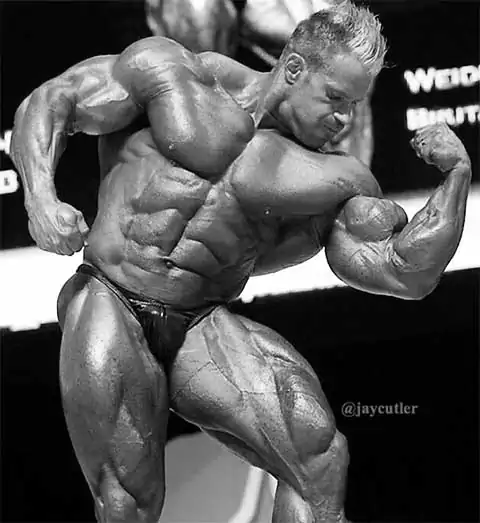
- Everyone knows you as a bodybuilder who likes to train late at night. Why?
There are a few reasons why I train late at night. First, because the gym is crowded during the day.
Second, I like knowing that I’m doing something that no one else is doing.
Also, I’m constantly exploring my body and want to better understand the conditions under which it reaches its best form.
The Mr. Olympia competition always takes place around 9-10 p.m., and it’s important for me to see how my body looks after 4-5 meals.
I usually train for two days in a row, then take a rest on the third; four times a day: two cardio sessions at home and two gym workouts. This routine is the secret to my physique.
I eat and train to be big. There are no secrets. Old-school heavy training with a clear goal.
“…I usually train for two days in a row, then rest on the third; four times a day: two cardio sessions at home and two gym workouts.”
Jay Cutler on training
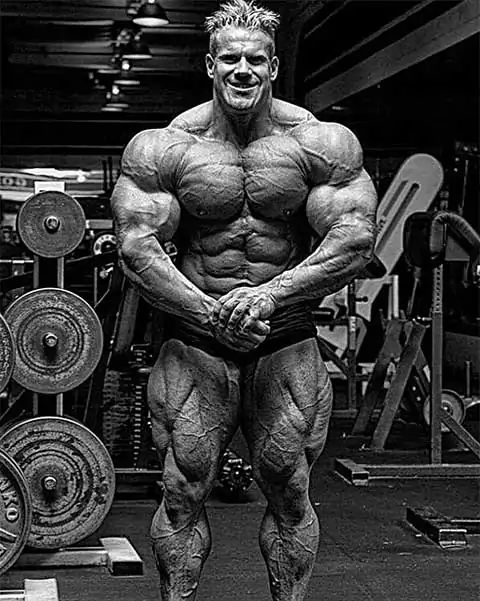
- A lot of young bodybuilders definitely come to you for advice. What do you usually tell them?
Most often, I advise them to be patient and consistent.
I also tell them that diet is one of the most important factors, because none of them eat enough, and none of them eat in a way that keeps them healthy.
They read various tips online, but the internet is both one of the best and worst inventions. For example, they read that I eat burgers and start doing the same. But I never ate them before I became Mr. Olympia. I need calories to maintain huge muscle mass.
All young guys need to just follow the right principles and understand that there’s no shortcut. I advise them to get enough sleep, train, and eat well. The quality of your workout is determined by the quality of the nutrition before it.
“…diet is one of the most important factors for success… none of the beginner bodybuilders eat enough, and none of them eat in a way that keeps them healthy.”
Jay Cutler on nutrition
- What is your usual workout and diet like today?
I train 5 days a week. After waking up, I do cardio. In every workout, I train one or two body parts.
I always tell everyone that today I eat half the amount of food I used to, and I use half the weight I used before. I also do fewer reps, 12-15 instead of 20.
Yesterday I did T-bar rows, but I plan to reduce the volume of those exercises, as well as deadlifts.
Today, I still eat 5-6 meals a day, but the portions are much smaller. For example, 150 grams of chicken instead of 300-360 grams as before, and 50 grams of rice compared to 100 grams previously.
Breakfast is still the same as always: egg whites and protein, an omelet. Breakfast has always been my biggest meal.
After training, I have a protein shake with a small amount of sugar and carbs. Overall, I try to keep my diet as simple as possible. My weight is still 120 kg, but I maintain lean muscle mass.
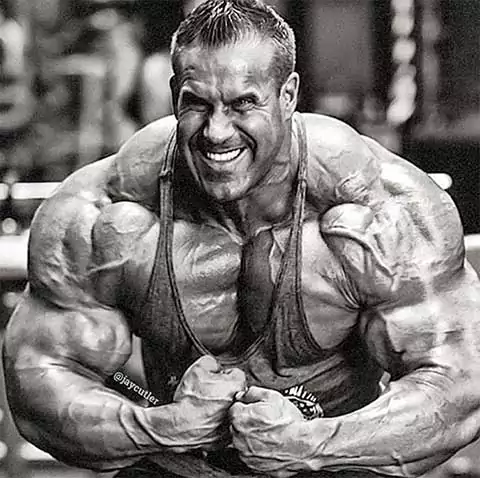
Example Workout Routine of Jay Cutler
Monday – Shoulders, Traps, Triceps & Abs
Shoulders
- Dumbbell Lateral Raises: 3 sets x 12 reps
- Dumbbell Press: 3 sets x 8-12 reps
- Cable Lateral Raises: 3 sets x 8-12 reps
- Barbell Front Raises: 2 sets x 10 reps
- Bent-Over Dumbbell Lateral Raises: 3 sets x 10 reps
Triceps
- Standing Cable Pushdowns: 4 sets x 15 reps
- Overhead Dumbbell Extension: 3 sets x 15 reps
- Close-Grip Barbell Press: 3 sets x 8 reps
- French Press: 3 sets x 8 reps
- Bent-Over Dumbbell Kickbacks: 3 sets x 12 reps
- Bench Dips: 3 sets x 15 reps
Traps
- Shrugs: 4 sets x 12 reps
Abs
- Crunches: 3 sets x 20 reps
- Cable Crunches: 3 sets x 20 reps
- Hanging Leg Raises: 3 sets x 12 reps
- Leg Raises: 3 sets x 10 reps
Tuesday – Back
- Lat Pulldowns to Chest: 3 sets x 10 reps
- Bent-Over Dumbbell Rows: 3 sets x 10 reps
- Bent-Over Barbell Rows: 4 sets x 10 reps
- Deadlifts: 3 sets x 12 reps
- T-Bar Rows: 3 sets x 10 reps
- Lat Pulldowns Behind Neck: 3 sets x 10 reps
- Seated Cable Rows: 3 sets x 10 reps
- Hyperextensions: 3 sets x 10 reps
Wednesday – Rest
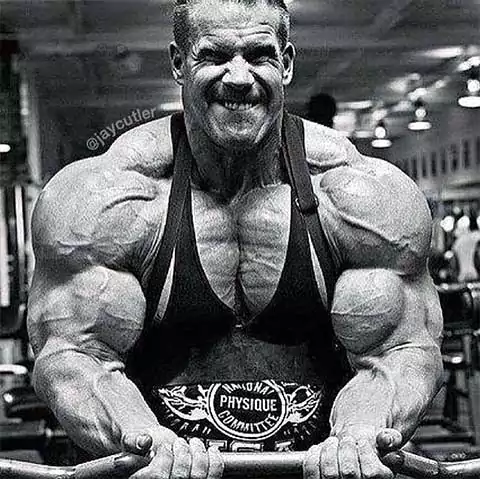
Thursday – Chest, Biceps, Forearms & Abs
Chest
- Incline Barbell Press: 5 sets x 10-12 reps
- Flat Dumbbell Press: 3 sets x 8-10 reps
- Incline Dumbbell Flyes: 3 sets x 10 reps
- Cable Crossovers: 3 sets x 12 reps
- Decline Barbell Press: 3 sets x 8 reps
Biceps
- Barbell Curls: 5 sets x 15 reps
- Dumbbell Curls: 3 sets x 12 reps
- Preacher Curls with Dumbbell: 3 sets x 10 reps
- Hammer Curls: 2 sets x 12-15 reps
Forearms
- Reverse Barbell Curls: 6 sets x 15 reps
Abs
- Crunches: 3 sets x 20 reps
- Cable Crunches: 3 sets x 20 reps
- Hanging Leg Raises: 3 sets x 12 reps
- Leg Raises: 3 sets x 10 reps
Friday – Legs
- Leg Extensions: 3 sets x 20 reps
- Leg Press: 4 sets x 12 reps
- Squats: 4 sets x 6-10 reps
- Barbell Lunges: 3 sets x 8 per leg
- Heavy Leg Extensions: 4 sets x 10 reps
We recommend: Strengthen Your Muscles with Boldaxyl 300
Saturday – Hamstrings, Calves & Abs
Hamstrings
- Lying Leg Curls: 6 sets x 12 reps
- Romanian Deadlifts: 3 sets x 10 reps
- Single-Leg Curls: 3 sets x 12 reps
- Leg Press (feet high and wide): 3 sets x 12 reps
Calves
- Standing Calf Raises: 4 sets x 10 reps
- Donkey Calf Raises: 2 sets x 10 reps
- Seated Calf Raises: 3 sets x 10 reps
Abs
- Crunches: 3 sets x 20 reps
- Cable Crunches: 3 sets x 20 reps
- Hanging Leg Raises: 3 sets x 12 reps
- Leg Raises: 3 sets x 10 reps
Sunday – Rest

